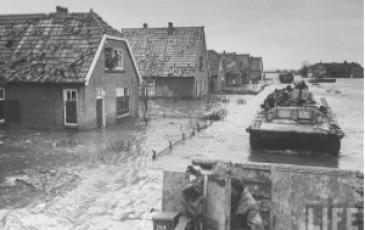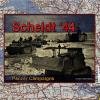#0917_02b_Market_Garden "It Never Snows in September" - PzC 24 Scheldt '44

 0 - 0 - 1
0 - 0 - 1

| Rating: | 4.27 (3) |
| Games Played: | 1 |
| SM: | 6 |
| Turns: | 85 |
| Type: | Stock |
| First Side: | Allies |
| Second Side: | Axis |
Date: 17 September 1944 - Size: Large - Description: Operation Market Garden (Hypothetical)
Scenario Briefing: In the last weeks of August and first weeks of September the Allies raced across France and Belgium, liberating town after town as the Germans retreated in disarray. Though German resistance stiffened as the Allies approached the Reich, it seemed to the Allied leadership that the Westheer was nearing collapse and that the Western Allies might end the war by Christmas. Perhaps one more bold maneuver could deliver a knockout blow and bring an end to the bloodshed in Europe
In early September Allied leaders entertained a range of proposals to employ airborne forces against the seemingly beaten German army. Perhaps the boldest of these designs was Operation Comet, proposed by Field Marshall Bernard Montgomery. Under this plan, British airborne forces would seize key bridges in the Netherlands. The British 2nd Army would advance through the paratroopers and straight into heart of Germany. Concentrated on a narrow front and provided with absolute priority for supply, the 2nd Army would act as an irresistible battering ram that could march all the way to Berlin. General Eisenhower, Supreme Commander of the Allied Expeditionary Force, deemed Operation Comet impractical because it did not include sufficient airborne forces to capture and hold the necessary bridges in the Netherlands and a single thrust on such a narrow front would leave the British Army's lines of supply unacceptably vulnerable. Eisenhower instead favored a broad front strategy and believed that the Westheer might collapse if put under constant pressure from the Swiss border to the sea. While he dismissed Comet (which could not have gone forward anyway due to rain), he greenlit Montgomery's second proposal.
The new plan consisted of two components, "Market" and "Garden," together "Operation Market Garden". Market Garden included similarities to the scrapped Operation Comet, but its objectives were more limited in scope and functioned as part of Eisenhower's larger "broad front" strategy. Scheduled for September 17th, "Market" consisted of a massive airborne assault in the Netherlands. The US 101st Airborne Division would drop north of Eindhoven and secure the bridges over the Wilhelmina Canal, the Dommel, the Zuid-Willemsvaart, and the Aa; the 82nd Airborne Division would drop south of Nijmegen to secure the bridges over the Maas, the Maas-Waal Canal, and the Waal; and finally the British 1st Airborne Division would land near Arnhem to secure a crossing over the Nederrijn. The ground assault, "Garden," was timed to coincide with the airborne landings. Led by the Guards Armoured Division, XXX Corps was to make the main effort. After breaking through the German defenses on the Dutch border, the Guards would speed up the highway and across the bridges secured by the airborne forces, presumably reaching Arnhem on September 19th. Follow up divisions would then advance beyond to the IJsselmeer. Meanwhile XII Corps and VIII Corps would make supporting attacks to secure XXX Corps' flanks, with XII Corps crossing the Bocholts-Herentals Canal at Lommel and pushing as far as 's-Hertogenbosch and VIII Corps forcing a crossing at Sint-Hubrechts- Lille and advancing all the way up to the Maas River near the German border. When the operation was complete the Allies would have outflanked the Westwall, thereby facilitating a future invasion of Germany, and they would have isolated the German 15. Armee in the Netherlands.
Market Garden was a daring plan, but it was also a dangerous one. Allied planners assumed that the German defense was no more than a thin crust along the Dutch-Belgian border and, once the Guards Armoured Division broke through, resistance in the Netherlands would collapse rapidly. They seriously underestimated the Germans' will to continue the fight and their capacity for improvisation. The remnants of two SS Panzer divisions were regrouping near Arnhem and various security, training, air, and naval forces had been mobilized as "alarm" units. Further reinforcements could be sent from Germany and from the regrouping 15. Armee elements that had recently been evacuated across the Scheldt. Neither XII nor VIII Corps could be made ready for an assault on the 17th, leaving XXX Corps vulnerable to counterattack from all sides. Perhaps the greatest flaw in the Allied plan is that it relied on clear skies. This was a big assumption for the Netherlands in September and within days the weather became a new enemy with clouds and rain hindering efforts to resupply and reinforce the airborne divisions. Envisioned as a swift coup de main, Market Garden was to bog down into a bloody fiasco which would culminate in the destruction of one of the Britain's elite divisions...
Design Notes:\1. This hypothetical scenario explores what might have happened if XII Corps and VIII Corps were ready to attack on September 17th. \2. 3rd and 53rd Infantry Divisions start fully assembled and available for use on the flanks of Guards Armoured Division and 4th Armoured Brigade and Piron Brigade hold the Zuid-Willemsvaart on the eastern extremity of the Allied lines. \3. The scenario uses the larger map found in #0917_01a.\4. This scenario should be played with the "Optional Amphibious Rules" optional rule to enable units with amphibious capability to cross the Waal and Nederrijn rivers.
Recommended Rules: [Default] \Alternative Assault Resolution, Artillery Set Up, Recon Spotting, Virtual Supply Trucks, Optional Surrender, Low Visibility Air Effects, Quality Fatigue Modifier, Optional Amphibious Rules, Counterbattery Fire, Night Fatigue, Programmed Weather, Limited Air Recon, Delayed Disruption Reporting, Extended Patrolling.
Scenario Briefing: In the last weeks of August and first weeks of September the Allies raced across France and Belgium, liberating town after town as the Germans retreated in disarray. Though German resistance stiffened as the Allies approached the Reich, it seemed to the Allied leadership that the Westheer was nearing collapse and that the Western Allies might end the war by Christmas. Perhaps one more bold maneuver could deliver a knockout blow and bring an end to the bloodshed in Europe
In early September Allied leaders entertained a range of proposals to employ airborne forces against the seemingly beaten German army. Perhaps the boldest of these designs was Operation Comet, proposed by Field Marshall Bernard Montgomery. Under this plan, British airborne forces would seize key bridges in the Netherlands. The British 2nd Army would advance through the paratroopers and straight into heart of Germany. Concentrated on a narrow front and provided with absolute priority for supply, the 2nd Army would act as an irresistible battering ram that could march all the way to Berlin. General Eisenhower, Supreme Commander of the Allied Expeditionary Force, deemed Operation Comet impractical because it did not include sufficient airborne forces to capture and hold the necessary bridges in the Netherlands and a single thrust on such a narrow front would leave the British Army's lines of supply unacceptably vulnerable. Eisenhower instead favored a broad front strategy and believed that the Westheer might collapse if put under constant pressure from the Swiss border to the sea. While he dismissed Comet (which could not have gone forward anyway due to rain), he greenlit Montgomery's second proposal.
The new plan consisted of two components, "Market" and "Garden," together "Operation Market Garden". Market Garden included similarities to the scrapped Operation Comet, but its objectives were more limited in scope and functioned as part of Eisenhower's larger "broad front" strategy. Scheduled for September 17th, "Market" consisted of a massive airborne assault in the Netherlands. The US 101st Airborne Division would drop north of Eindhoven and secure the bridges over the Wilhelmina Canal, the Dommel, the Zuid-Willemsvaart, and the Aa; the 82nd Airborne Division would drop south of Nijmegen to secure the bridges over the Maas, the Maas-Waal Canal, and the Waal; and finally the British 1st Airborne Division would land near Arnhem to secure a crossing over the Nederrijn. The ground assault, "Garden," was timed to coincide with the airborne landings. Led by the Guards Armoured Division, XXX Corps was to make the main effort. After breaking through the German defenses on the Dutch border, the Guards would speed up the highway and across the bridges secured by the airborne forces, presumably reaching Arnhem on September 19th. Follow up divisions would then advance beyond to the IJsselmeer. Meanwhile XII Corps and VIII Corps would make supporting attacks to secure XXX Corps' flanks, with XII Corps crossing the Bocholts-Herentals Canal at Lommel and pushing as far as 's-Hertogenbosch and VIII Corps forcing a crossing at Sint-Hubrechts- Lille and advancing all the way up to the Maas River near the German border. When the operation was complete the Allies would have outflanked the Westwall, thereby facilitating a future invasion of Germany, and they would have isolated the German 15. Armee in the Netherlands.
Market Garden was a daring plan, but it was also a dangerous one. Allied planners assumed that the German defense was no more than a thin crust along the Dutch-Belgian border and, once the Guards Armoured Division broke through, resistance in the Netherlands would collapse rapidly. They seriously underestimated the Germans' will to continue the fight and their capacity for improvisation. The remnants of two SS Panzer divisions were regrouping near Arnhem and various security, training, air, and naval forces had been mobilized as "alarm" units. Further reinforcements could be sent from Germany and from the regrouping 15. Armee elements that had recently been evacuated across the Scheldt. Neither XII nor VIII Corps could be made ready for an assault on the 17th, leaving XXX Corps vulnerable to counterattack from all sides. Perhaps the greatest flaw in the Allied plan is that it relied on clear skies. This was a big assumption for the Netherlands in September and within days the weather became a new enemy with clouds and rain hindering efforts to resupply and reinforce the airborne divisions. Envisioned as a swift coup de main, Market Garden was to bog down into a bloody fiasco which would culminate in the destruction of one of the Britain's elite divisions...
Design Notes:\1. This hypothetical scenario explores what might have happened if XII Corps and VIII Corps were ready to attack on September 17th. \2. 3rd and 53rd Infantry Divisions start fully assembled and available for use on the flanks of Guards Armoured Division and 4th Armoured Brigade and Piron Brigade hold the Zuid-Willemsvaart on the eastern extremity of the Allied lines. \3. The scenario uses the larger map found in #0917_01a.\4. This scenario should be played with the "Optional Amphibious Rules" optional rule to enable units with amphibious capability to cross the Waal and Nederrijn rivers.
Recommended Rules: [Default] \Alternative Assault Resolution, Artillery Set Up, Recon Spotting, Virtual Supply Trucks, Optional Surrender, Low Visibility Air Effects, Quality Fatigue Modifier, Optional Amphibious Rules, Counterbattery Fire, Night Fatigue, Programmed Weather, Limited Air Recon, Delayed Disruption Reporting, Extended Patrolling.
| Gaming Records | |||||||||
|---|---|---|---|---|---|---|---|---|---|
| 1st Side Player | 2nd Side Player | Result | Score | ||||||
 |
devoncop | vs. | agmoss99 |  |
Axis Major Victory | 108 | 12 | ||






















I have rated it a 7 as from the German viewpoint this was enjoyable as the above points were not obvious to me as I played so I still felt it some measure of challenge.